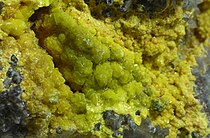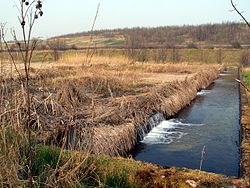Bioremediation of radioactive waste
| Part of a series on |
| Pollution |
|---|
 |
Bioremediation of radioactive waste or bioremediation of radionuclides is an application of
The techniques of bioremediation of environmental areas as
The species involved in these processes have the ability to influence the properties of radionuclides such as
Areas contaminated by radioactivity
Typology of radionuclides and polluting waste
The presence of radioactive waste in the environment may cause long-term effects due to the
The sources of radioactivity are not exclusive of human activity.
The most frequent radionuclides in soils are naturally
At the same time,
In ocean waters, the presence of
| Frequency of occurrence of selected radionuclides at US DOE facilities | |||||
| Ground water | Soils/Sediments | ||||
 |
 | ||||
| Source: US Government (1992)[12]
| |||||
The classification of radioactive waste established by the International Atomic Energy Agency (IAEA) distinguishes six levels according to equivalent dose, specific activity, heat released and half-life of the radionuclides:[13]
- Exempt waste (EW): Waste that meets the criteria for exclusion from regulatory control for radiation protection purposes.
- Very short lived waste (VSLW): Waste with very short half-lives (often used for research and medical purposes) that can be stored over a limited period of up to a few years and subsequently cleared from regulatory control.
- Very low level waste (VLLW): Waste like soil and rubble (with low levels of activity concentration) that may also contain other hazardous waste.
- Low level waste (LLW): Waste that is above clearance levels and requires robust isolation and containment for periods of up to a few hundred years and is suitable for disposal in engineered near surface facilities. LLW include short lived radionuclides at higher levels of activity concentration and also long lived radionuclides, but only at relatively low levels of activity concentration.
- Intermediate level waste (ILW): Waste with long lived radionuclides that requires a greater degree of containment and isolation at greater depths.
- High level waste (HLW): Waste with large amounts of long lived radionuclides that need to be stored in deep, stable geological formationsusually several hundred metres or more below the surface.
Ecological and human health consequences
Radioactive contamination is a potential danger for living organisms and results in external hazards, concerning radiation sources outside the body, and internal dangers, as a result of the incorporation of radionuclides inside the body (often by
In humans, single doses from 0.25
The information available on the effect of natural background radiation with respect anthropogenic pollution on
Radiation tests in
- Chromosomal aberrations.
- DNA damage.
- Cancer, particularly leukemia.[2]
- Leukopenia.
- Growth reduction.
- Reproductive deficiencies: sterility, reduction in fecundity, and occurrence of developmental abnormalities or reduction in viability of offspring
- Reduced seed germination.
- Burned tissues exposed to radiation.
- Mortality, including both acute lethality and long-term reduction in life span.
The effects of radioactivity on
Its action on viruses, on the other hand, results in damaged
Bacterial bioremediation
The biochemical transformation of radionuclides into stable isotopes by
Radioisotopes can be transformed directly through changes in
Bioreduction
According to the radioactive element and the specific site conditions, bacteria can enzymatically immobilize radionuclides directly or indirectly. Their
Direct enzymatic reduction is the change of radionuclides of a higher oxidation state to a lower one made by
The
Other radioactive
The phenomenon of indirect enzymatic reduction is carried out by
There are several species of reducing microorganisms that produce indirect
Citrate complexes
Biosorption, bioaccumulation and biomineralization

The set of strategies that comprise biosorption, bioaccumulation and biomineralization are closely related to each other, because one way or another have a direct contact between the cell and radionuclide. These mechanisms are evaluated accurately using advanced analysis technologies such as
Biosorption and bioaccumulation are two metabolic actions that are based on the ability to concentrate radionuclides over a thousand times the concentration of the environment. They consist of complexation of radioactive waste with
Biosorption method is based on passive sequestration of positively charged radioisotopes by
Quantitative analyzes determine that, in the case of uranium, biosorption may vary within a range between 45 and 615
Bioaccumulation refers to uptake of radionuclides into the cell, where they are retained by complexations with negatively charged intracellular components, precipitation or

Furthermore, biomineralization —also known as bioprecipitation— is the
Investigations of terrestrial and marine bacterial isolates belonging to the genera Aeromonas, Bacillus, Myxococcus, Pantoea, Pseudomonas, Rahnella and Vibrio have also demonstrated the removal of uranium radioisotopes as phosphate biominerals in both oxic and anoxic growth conditions.[25]
Biostimulation and bioaugmentation
Aside from bioreduction, biosorption, bioaccumulation and biomineralization, which are bacterial strategies for natural attenuation of radioactive contamination, there are also human methods that increase the efficiency or speed of microbial processes. This accelerated natural attenuation involves an intervention in the contaminated area to improve conversion rates of radioactive waste, which tend to be slow. There are two variants: biostimulation and bioaugmentation.[30]
Biostimulation is the addition of nutrients with
A number of
Bioaugmentaton, on the other hand, is the deliberated addition to the environment of microorganisms with desired traits to accelerate bacterial metabolic conversion of radioactive waste. They are often added when necessary species for bioremediation do not exist in the treatment place.
Genetic engineering and omics

Omics, especially genomics and proteomics, allow identifying and evaluating
From this information, different genetic engineering and
Plant bioremediation

The use of plants to remove contaminants from the environment or to render them less harmful is called phytoremediation. In the case of radionuclides, it is a viable technology when decontamination times are long and waste are scattered at low concentrations.[32][33]
Some plant species are able to transform the state of radioisotopes (without suffering toxicity) concentrating them in different parts of their structure, making them rush through the roots, making them volatile or stabilizing them on the ground. As in bacteria, plant
Phytoextraction
In phytoextraction (also phytoaccumulation, phytosequesteration or phytoabsorption)
Species like
Rhizofiltration

Rhizofiltration is the adsorption and precipitation of radionuclides in plant roots or absorption thereof if soluble in effluents. It has great efficiency in the treatment of
From this process, some strategies have been designed based on sequences of
The most promising plants for rhizofiltration are
Phytovolatilization
Phytovolatilization involves the capture and subsequent transpiration of radionuclides into the atmosphere. It does not remove contaminants but releases them in volatile form (less harmful). Despite not having too many applications for radioactive waste, it is very useful for the treatment of tritium, because it exploits plants' ability to transpire enormous amounts of water.[33][34]
The treatment applied to tritium (shielded by air produces almost no external radiation exposure, but its incorporation in water presents a health hazard when absorbed into the body) uses polluted effluents to irrigate phreatophytes. It becomes a system with a low operation cost and low maintenance, with savings of about 30% in comparison to conventional methods of pumping and covering with asphalt.[33]
Phytostabilization
Phytostabilization is an specially valid strategy for radioactive contamination based on the immobilization of radionuclides in the soil by the action of the roots. This can occur by adsorption, absorption and precipitation within root zone, and ensures that radioactive waste can not be dispersed because soil erosion or leaching. It is useful in controlling tailings from strip and open pit uranium mines, and guarantees to retrieve the ecosystem.[33][34] However, it has significant drawbacks such as large doses of fertilizer needed to reforest the area, apart from radioactive source (which implies long-term maintenance) remaining at the same place.[citation needed]
Fungal bioremediation
Several fungi species have radioactive resistance values equal to or greater than more radioresistant bacteria; they perform mycoremediation processes. It was reported that some fungi had the ability of growing into, feeding, generating
Since then, it has been shown that some species of
Ways of research
Current research on bioremediation techniques is fairly advanced and molecular mechanisms that govern them are well known. However, there are many doubts about the effectiveness and possible adversities of these processes in combination with the addition of
Longevity effects of some bacterial processes, such as maintenance of uranium in insoluble form because of bioreductions or biomineralizations, are unknown. There are not clear details about the
Another important aspect is the change of
Finally, the potential of
See also
- List of environment topics
- Living machines
- Dutch standards
- Actinides in the environment
- Restoration ecology
- Uranium mining debate
- Radiobiology
- Nuclear power
References
- ^ a b c d e f g Faison, B; McCullough, J; Hazen, TC; Benson, SM; Palmisano, A (2003). A NABIR Primer (ed.). Bioremediation of metals and radionuclides: What it is and how it works (PDF) (2nd edition. Revision by the Lawrence Berkeley National Laboratory ed.). Washington: United States Department of Energy. Archived from the original (PDF) on 2021-01-25. Retrieved 2016-05-20.
- ^ PMID 23617701.
- ^ .
- ^ ISBN 978-1-78242-231-0.
- ^ a b Francis, A.J (2006). Microbial Transformations of Radionuclides and Environmental Restoration Through Bioremediation (PDF). Symposium on "Emerging Trends in Separation Science and Technology". Mumbai: Brookhaven National Laboratory.
- ^ Consejo de Seguridad Nuclear. Ministerio de Industria, Turismo y Comercio de España (ed.). "Radiación natural y artificial" (Web) (in Spanish). Retrieved 24 February 2016.
- ISBN 978-82-92538-01-2.
- ^ a b c Idaho State University (ed.). "Radioactivity in Nature". Archived from the original (Web) on 5 February 2015. Retrieved 25 February 2016.
- ^ PMID 18819734.
- ISBN 9781483219837.
- )
- doi:10.2172/10147081.
- )
- ^ ISBN 9788182830127.
- PMID 14610281.
- ^ Linsley, G (1997). "Radiation & the environment: Assessing effects on animals and plants" (PDF). IAEA Bulletin.
- ISSN 1569-4860.
- ^ a b Barnthouse, L.W (1995). Environmental Sciences Division (ed.). "Effects of ionizing radiation on terrestrial plants and animals: a workshop report" (PDF) (4496). Tennessee: United States Department of Energy. Archived from the original (PDF) on 2016-12-21. Retrieved 2016-05-21.
{{cite journal}}: Cite journal requires|journal=(help) - The Popular Science Monthly. 74. New York: 222–232.
- .
- PMID 14363075.
- ISBN 9780080543581.
- ISSN 1566-7693.
- ISBN 9780857097194.
- ^ .
- ^ S2CID 129843161.
- ISBN 9783319221717.
- ISBN 9781843390015.
- ^ Chang, Y (2005). "In Situ Biostimulation of Uranium Reducing Microorganisms at the Old Rifle UMTRA Site" (Web). Doctoral Dissertations. Knoxville.
- ^ a b c Natural and Accelerated Bioremediation Research. United States Department of Energy (ed.). "II. Program Goals and Management Strategy" (Web). Retrieved 14 May 2015.
- )
- ISBN 9780080474892.
- ^ S2CID 43065577.
- ^ ISBN 9783319076652.
- ^ "Rhizofiltration". www.hawaii.edu. Retrieved 2022-06-18.
- ^ PMID 18848901.
- .
- ISBN 9780521845793.
- S2CID 96123551.
- PMID 10819188.
External links
- Dengra Grau, F. Xavier. Bioremediation of radioactive waste. (PDF) Scientific poster of the Bachelor Thesis related to this article. Autonomous University of Barcelona Digital Repository of Documents.
